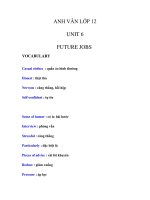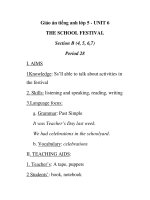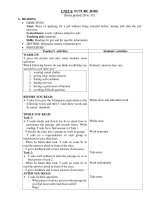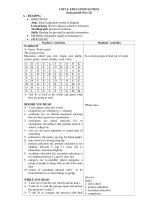UNIT 6: FUTURE JOBS (from period 28 to 33) ppt
Bạn đang xem bản rút gọn của tài liệu. Xem và tải ngay bản đầy đủ của tài liệu tại đây (3.88 MB, 12 trang )
UNIT 6: FUTURE JOBS
(from period 28 to 33)
A. READING
OBJECTIVES
Aims: Ways of applying for a job without being stressful before, during and after the job
interview.
Lexical items: words / phrases related to jobs
Teaching aids: handouts
Skills: Reading for gist and for specific information
METHOD: Integrated, mainly communicative
PROCEDURE:
Teacher’s activities Students’ activities
WARM-UP:
T gives the picture and asks some students some
questions:
Which following factors do you think would help you
succeed in a job interview?
1. wearing casual clothes
2. giving clear, hones answers
3. feeling self-confident
4. feeling nervous
5. having a good sense of humour
6. avoiding difficult question
BEFORE YOU READ:
T asks Ss to give the Vietnamese equivalents to the
following words and then T reads these words and
Ss repeat. (handout)
WHILE YOU READ:
Task 1:
T reads loudly and slowly for Ss to check how to
pronounce the passage and rereads faster. While
reading, T asks Ss to find answers in Task 1
- T divides the class into 4 groups to work in groups.
- T calls on a representative of each group to
blackboard to give their keys.
- When Ss finish their task, T calls on some Ss to
read the answers aloud in front of the class.
- T gives feedback and correct answers if necessary.
Task 2:
T asks each student to skim the passage so as to
find answer of task 2
- When Ss finish their task, T calls on some Ss to
read the answers aloud in front of the class.
- T gives feedback and correct answers if necessary.
AFTER YOU READ:
T asks Ss these questions:
- What pieces of advice given in the passage do
you find most useful and least useful?
- Why?
Students’ answers may vary
Whole class and individual work
Whole class
Work in groups
Take notes
Work individually
Take notes
Work individually
T gives comments and assigns homework:
Homework:
- learn new words
- do Task 1, 2 in the book.
- Prepare for Unit 6 - Speaking
HANDOUT:
Vocabulary and Expressions:
1. casual (adj.) ['kỉʒjuəl] = informal: bình thường -> casual clothes: quần áo bình thường
2. honest (adj.) ['ɔnist]: thành thực, thật thà
3. nervous (adj.) ['nə:vəs]: nóng nảy, hoảng sợ, lo lắng bồn chồn
4. humour (n) ['hju:mə]: hài hước, hóm hỉnh
5. stressful (adj.) ['stresfl]: gây căng thẳng
6. pressure (n) ['pre∫ə(r)]: sức ép, áp lực
7. impression (n) [im'pre∫n]: ấn tượng
8. vacancy (n) ['veikənsi]: một vò trí hay một chức vụ còn trống
9. a letter of application [,ỉpli'kei∫n]: thư xin việc
10. résumés (n) [ri'zju:m] = curriculum vitae: sơ yếu lý lòch
11. candidate (n) ['kỉndidit]: người xin việc, người ứng cử
12. certificate (n): giấy chứng nhận, bằng cấp, chứng chỉ
13. recommendation (n) [,rekəmen'dei∫n]: sự giới thiệu
14. to jot down (exp.) = to make a quick written not of: ghi lại tóm tắt
15. qualification (n) [,kwɔlifi'kei∫n]: phẩm chất, năng lực
16. technical (adj) ['teknikl]: thuộc kó thuật, chuyên môn
17. aspect (n) ['ỉspekt]: khía cạnh, vẻ bề ngoài, mặt
18. to dress (v) [dres]: mặc, ăn mặc
19. keenness (n) ['ki:nnis]: sự đam mê, tính sắc sảo
20. comment (n) ['kɔment]: lời bình luận, lời phê bình
B. SPEAKING
OBJECTIVES
Aims: by the end of the lesson, Ss will be able to give opinions about jobs.
Lexical items: words / phrases related to jobs.
Teaching aids: handouts
Skills: giving how to reply compliments in different situations
METHOD: Integrated, mainly communicative
PROCEDURE:
Teacher’s activities Students’ activities
WARM-UP:
T makes some questions to Ss:
- What is your mother’s job?
- What is it?
- What about your father?
BEFORE YOU SPEAK:
T gives vocabulary and useful expressions :
* Vocabulary:
1. tourist guide ['tuərist gaid]: hướng dẫn viên du lòch
2. to take care (exp.): chăm sóc
3. character (n) ['kỉriktə]: nhân vật
4. construct (v) [kən'strʌkt]: làm xây dựng
5. irrigation (n) [,iri'gei∫n]: sự tưới nước
6. technique (n) [tek'ni:k]: kỹ thuật, kỹ xảo
Students’ answers may vary
Whole class
7. pilot (n) ['pailət]: phi công
8. receptionist (n) [ri'sep∫ənist]: người tiếp tân, tiếp
viên
9. computer programmer 'prougrỉmə]: lập trình viên
vi tính
WHILE YOU SPEAK:
Task 1:
T asks Ss to work in pairs task 1. Ss should match
a job in A with at least two descriptions in B.
- T goes around class to help Ss when necessary.
- T calls on some pairs to practice in front of the
class.
Task 2:
T asks Ss to work in pairs task 2. Ss ask and
answer which of the jobs they would/would not
like to do. Explain why/why not? (handout).
- T goes around to control and give help if necessary.
- T calls on a pair of students displaying in front of
the class.
- T gives comments and makes necessary corrections.
Task 3:
T asks Ss to work in pairs task 3. Ss practice
responding about a job they may do after you
finish school (handout).
- T goes around to control and give help if necessary.
- T calls on a pair of students displaying in front of
the class.
- T gives comments and makes necessary corrections.
AFTER YOU SPEAK:
T asks Ss this situation:
- Do you want to be a teacher?
- Why (not)?
Work in pairs
Take notes
Work in pairs
Take notes
Work in pairs
Take notes
Students’ answers may vary
T gives comments and assigns homework:
Homework:
- Learn how to give and respond
compliments in each situation
- Prepare for unit 6 - Listening
* Handouts
Task 2:
Samples: Jobs that you like
(1) Student 1 : Which of the jobs in column A you would like to do?
Student 2 : It is a _______ .
A. taxi driver B. electrician C. journalist D. computer programmer
(2) Student 1 : Why?
Student 2 : Because I can ______
A. write things that you don’t know about our daily life happened
B. help everyone from place to place more easier.
C. design some programs that are useful to accounting, saving data and solving much complex
problems.
D. repair and fix the family electric system.
Samples: Jobs that you don’t like
(1) Student 1 : Which of the jobs in column A you wouldn’t like to do?
Student 2 : It is a _______ .
A. taxi driver B. electrician C. journalist D. computer programmer
(2) Student 1 : Why?
Student 2 : Because ______
A. it is really dangerous
B. I have to go many places.
C. I must work all day in a car.
D. I can not work many hours on a computer.
Task 3:
* Sample:
(1) Student 1: What are you going to do after you finish school?
Student 2: I think I will be a ____________
(2) Student 1: Where will you work, near your house or in another town?
Student 2: I will work ________________
(3) Student 1: Who will you work with?
Student 2: I will work with _____________
(4) Student 1: How may you get paid?
Student 2: Maybe ____________
(5) Student 1: How are the working conditions?
Student 2: ___________________________
C. LISTENING
OBJECTIVES
Aims: by the end of the lesson, Ss will be able to listen and get information from the talk of the
recent changes in the US job market and give some predications for future jobs.
Lexical items: words / phrases related to jobs
Teaching aids: a tape of English 12, a cassette player
METHOD: Integrated, mainly communicative by filling in missing information and deciding
On true or false statements
PROCEDURE:
Teacher’s activities Students’ activities
WARM-UP:
T gives the most popular jobs in a town and
makes some questions below:
- Which is the most popular job in your town?
The most popular jobs in your town
- seller
- worker
- farmer
- teacher
- doctor
- computer
programmer
BEFORE YOU LISTEN:
T asks Ss to give the Vietnamese equivalents to
the following words and then T reads these words
and Ss repeat.
Listen and repeat:
Ss answer the questions individually
Listen and repeat
1. workforce (n) ['wə:k'fɔ:s]: lực lượng lao động
2. manufacturing (n) [mỉnju'fỉkt∫əriη]: sự sản xuất,
chế tạo
3. retail (n) ['ri:teil]: sự bán lẻ
4. service (n/v) ['sə:vis]: dòch vụ, phục vụ
5. economy (n) [i:'kɔnəmi]: kinh tế
6. wholesale (n) ['houlseil]: sự bán sỉ
7. category (n) 'kỉtigəri]: hạng, loại
8. goods (n) [gudz]: hàng hoá, sản phẩm
9. job market ['mɑ:kit]: thò trường công việc
* Vocabulary:
1. sector (n) ['sektə]: bộ phận, khu vực, lónh vực
2. predication (n) [,predi'kei∫n]: sự tiên đóan
3. shift (n) [∫ift]: ca làm việc
4. transportation (n) [,trỉnspɔ:'tei∫n]: sự vận chuyển
5. finance (n) ['fainỉns; fi'nỉns]: tài chính
6. medicine (n) ['medsn; 'medisn]: thuốc, y học
WHILE YOU LISTEN:
Task 1: Fill in the missing words
T asks Ss to listen individually to the passage of
the recent changes in the US job market and then
fill in the missing words.
- Play the tape twice.
- Call on some Ss to give the answers
- Give correct answers if necessary.
Task 2: gap – filling
T asks Ss to re-listen individually to the passage
then Ss give whether Statements are True (T) or
False (F)
- Play the tape twice.
- Call on some Ss to give the answers
- Give correct answers if necessary.
AFTER YOU LISTEN:
T asks Ss to work in pairs by asking and
answering after listening again and summarize
the talk, using the information in Task 1 and 2
based on table of questions (handout) and giving
answers.
- T asks Ss to be divided into four groups and each
group summarize the passage.
- T calls on representative of each group to go to
blackboard and list the things how to use the
telephone in the family.
- T corrects their mistakes if necessary.
Individual work
Listen the tape
Take notes
Individual work
Listen to the tape
Take notes
Work in pairs
Ss work in groups
Take notes
T gives comments and assigns homework:
Homework:
- prepare for Unit 6 - Writing
* Handout:
Questions A Answer B
1 How many main groups is American workforce
separated into?
2 What are they?
3 How many categories are service jobs divided
into?
4 What are they?
5 How was service jobs one hundred year ago?
6 How is it today?
7 How will it be by the year 2020?
“American workforce is separated into two main groups: manufacturing jobs and service jobs.
Manufacturing jobs are producing cars, making and producing things. And service jobs are providing
services an example of washing cars in those that divided into five categories: transportation
companies, wholesale companies, retail companies, finance companies and personal services such as
hotels, cars repair, accounting, education and medicine. One hundred years ago, 80% of workers
produced goods, today only 30% do. Maybe by the year 2020, nine out of every ten workers will work in
service jobs.”
D. WRITING
OBJECTIVES
Aims: by the end of the lesson, Ss will be able to write a formal letter of job application.
Lexical items: words / phrases related to a formal letter of job application
Teaching aids: a series of questions related to sentence structures
Skills: give ideas and combine those logically to write a formal letter of job application
METHOD: Integrated, mainly communicative
PROCEDURE:
Teacher’s activities Students’ activities
WARM-UP:
T introduces the lesson by review the letter in the
previous lesson 5 (handout 1 and 2)
BEFORE YOU WRITE:
T gives some structures and vocabulary related to
Task 1 and 2:
1. travel company: công ty du lòch
2. local guide: hướng dẫn viên đòa phương
3. diploma: bằng tốt nghiệp
4. manner: ứng xử
5. fluent (adj): lưu loát
6. contact (v): liên hệ
7. character (n): tính cách
8. willingness (n): sự sẵn sàng
9. manage (v): quản lý
10. accompany (v): hứơng dẫn
WHILE YOU WRITE:
Task 1:
T asks Ss to work in pairs to read the
advertisement and fill in the notes
- T goes around to help if necessary.
- T calls on each pair to display the key
- T feedbacks and explains more
Task 2:
Give questions, if necessary.
Whole class
Work in pairs
Give keys
Take notes
T divides the class into 4 group and asks Ss to
write a letter to Vinatour, applying for the job
mentioned in the advertisement in Task 1. (handout
3)
- T goes around to help if necessary.
- T calls on a representative of each group to
blackboard to give answers
- T feedbacks and explains more
AFTER YOU WRITE:
T summarizes the content of the writing
Work in groups
Give keys
Take notes
T gives comments and assigns homework:
Homework:
- Do some more exercises given
* Handout 1:
* Review: Cách viết một lá thư
The Way Of Writing A Friendly Letter
1. Heading (Có thể ghi họ tên người
viết)
Số nhà, tên đường phố,
Tên Thành phố hay tỉnh,
Tên nước.
Ngày …….tháng … năm
2. Greeting
3. Body
4. Closing
Dear (+ first name/ Mr., Mrs., Miss, Mss + last name/position: Dr. + last name),
Đây là thông tin cần trao đổi giữa người viết và người đọc. Phần
này nên viết ngắn gọn, chính xác và dễ đọc (hiểu). Tránh rườm rà.
Giọng văn cần vui vẻ tự nhiên và thành thật. Chú ý chữ đầu mỗi
đoạn phải viết lùi vào một chút và khi xuống hàng nên viết dời ra
bằng với từ “Dear”.
Đọan văn khác tiếp theo ta cũng viết như đọan trứơc nhưng nên
cách xuống một hàng cho đẹp hình thức.
Khi kết thúc nội dung thư: tùy theo từng mục đích viết thư (thư mời,
thư cảm ơn, ….) mà cần nên chọn nội dung thư cho phù hợp. Nhớ là sau
lời chào (greeting) và kết thư (closing) luôn luôn có dấu phẩy (,). Còn
phần tái bút muốn ghi thêm thì cũng giống như đọan văn trong thư nhưng
cũng phải ký tên thêm một lần nữa.
5. Signature Your friend,
Mary
P.S.:
Là phần tái bút ghi phía dưới chữ ký và ký tên thêm một lần
nữa.
* Handout 2: a letter of request in the previous lesson 5
1. Heading
2. Greeting
3. Body
4. Closing
Dear Sir or Madam,
I am a Vietnamese student. I have just finished grade 10, the first grade of upper
secondary education. I often get the information about education from the internet,
and I am very interested in tertiary study in England. Therefore, I have decided to
write to the UCAS to ask for some information about the admission requirements to
Oxford University, which is one of the best universities in the world providing
students with the best knowledge of all subjects taught by excellent professors.
First, as a foreign student, I would like to know how long the undergraduate
programme is, how many examinations there are during the course and when the
examination for me to talk to my parents so that they can plan everything for my
students or not. If it doesn’t have any dormitories, could you recommend me and
English family where I can stay for my studies, and of course I’ll pay the rent on
time.
I think that I can follow this undergraduate programme at Oxford University
because my English is good. I got grade A in the TOEFL examination. I also have a
record of grade 10, a certificate of lower secondary education and an English
proficiency.
I hope you will consider my application form and offer me a place in order that
I can study at Oxford University in the future.
5. Signature
P.S.:
* Handout 3: Đặt các yêu cầu trong Task 2 vào hình thức sau
1. Heading
2. Greeting
3. Body
Dear
(Introduction)
4. Closing
(Request)
(Further information)
(conclusion)
5. Signature
P.S.:
* Handout 3:
Introduction
Say where you saw the advertisement
and why you are writing the letter of
application
1. Where did you see the advertisement?
2. Why are you writing the letter of
application?
Request Mention your education, work
experience and your character/interests
* Education:
3. What kind of certificate were you
awarded?
4 When?
* work experience:
5. What did you do after leaving high
school and what did you work for?
6. How was your experience while
working as an accountant?
7. Is there any experience as tour guide?
8. How do you know about Vietnam?
* character/interests
9. How do you speak English?
10. How are your characters?
11. Can you work hard for a long hours?
Conclusion Express your willingness to work for the
company and when you are available for
interview.
12. Would you like to work for them?
13. What do you think if you have a
opportunity to discuss this position?
E. LANGUAGE FOCUS
OBJECTIVES
Aims: by the end of the lesson, Ss will be able to know how to pronounce weak and strong forms
of some conjunctions and propositions and how to use relative clauses.
Teaching aids: handouts
METHOD: Integrated, mainly communicative
PROCEDURE:
Teacher’s activities Students’ activities
PRONUNCIATION: Weak and strong forms of
some conjunctions and prepositions
T gives some words having many kinds of
conjunction and prepositions; and then asks Ss to
find out each kind (handout 1)
- T corrects mistakes if necessary
- play the tape
- T explains the ways of them.
T asks Ss to listen the tape and then listen and
repeat “Practise reading these sentences in the
page of 38” and go the exercise (handout 2)
T calls on each student practicing aloud in front
of the class and then T gives mistakes and
explains more.
T divided the class into 6 groups to do each
sentence in its in order to find out which two –
syllable there are
- Go around and help Ss if necessary
- Call on a representative of each group to
blackboard to give keys
- Feedback and explain more
GRAMMAR: Review of Relative clause
* Review (handout 3)
T reminds Ss about the form and the usage of
Relative clause. (handout 3)
Give some new vocabulary and expressions:
1. to blame (v): đổ lỗi
2. to turn off (exp.): tắt
3. for (n): sương mù
4. to descend (v):
5. to import (v) # export: nhập khẩu
6. cowboy (n):
7. to fell off (exp.)
8. to be wounded (exp.): bò thong
9. arrow (n):
10. to recovered (v):
11. to be injured (exp.): bò thong
12. crash (n): vụ va chạm
13. anxiously (adv): lo lắng
Exercise 1:
T gives some relevant examples to Exercise 1 and
makes some questions to Ss about the learned
Relative clauses.
- T divides the class into 10 groups to find out
keys
- Go around and help Ss if necessary
- Call on a representative of each group to
blackboard to give keys
- Feedback and explain more
Ss work in individually and whole class
Ss listen to the tape and pay attention to the
two-syllable words
Ss listen the tape and then repeat the
practices in the book .after the teacher.
Listen and take notes
Whole class
Work in groups
Exercise 1:
1. whom
2. which
3. whoever
4. which
5. which
6. who
7. whose
8. who
9. which
10. whom
Exercise 2:
T gives some relevant examples to Exercise 2 and
makes some questions to Ss about the learned
reported speech.
- T divides the class into 10 group to find out
keys
- Go around and help Ss if necessary
- Call on a representative of each group to
blackboard to give keys
- Feedback and explain more
Work in groups
Exercise 2:
1. I read a book that was written by a friend
of mine
= I read a book written by a friend of mine
2. A man who was carrying a lot of money
in a box got on the bus
= A man carrying a lot of money in a box
got on the bus
3. In the street there were several people
were waiting for the shop to open
= In the street there were several people
waiting for the shop to open
T gives comments and assigns homework:
Homework:
- prepare for Unit 7 – A. Reading
* Handout 1:
Conjunctions Prepositions
Strong form Weak form Strong form Weak form
And
[ỉnd] [ənd, ən]
At
[ỉt] [ət]
But
[bʌt] [bət]
For
[fɔ] [fə]
Of
[ɔv] [əv]
To
[tu:] [tu, tə]
from
[frɔm] [frəm]
* Handout 2
Conjunctions Prepositions
Strong form Weak form Strong form Weak form
1
2
3
4
5
6
7
8
9
10
* Handout 3
Danh từ đứnt trước Chủ ngữ Tân ngữ Sở hữu
Who Who(m) Người
That (người k xác đònh)
Whose
Which Vật
That (vật k xác đònh)
Whose/of which
Thời gian When
Nơi chốn Where
Lý do Why
* Các trường hợp phải chú ý:
1. Defining Relative clauses (Mệnh đề giới hạn = Mệnh đề xác đònh):
- Danh từ đứng trước không xác đònh ( không rõ nghóa) nên không được lược bỏ R.clause
Ex.: a. I met someone who said he knew you (who = that)
b. I met someone who you said to me.
- R.pronoun làm túc từ có thể lược bỏ
b. I met someone you said to me
2. Non-defining Relative clauses (Mệnh đề không giới hạn = Mệnh đề không xác đònh)
- Danh từ đứng trước xác đònh (rõ nghóa) nên có thể lược bỏ.
Ex.: a. I met Mr. Smith, who said he knew you (that không thay cho who)
b. I met Mr. Smith, who you said to me
- R.pronoun là túc từ không lược bỏ
b. I met Mr. Smith, who you said to me
3. Các trường hợp phải và không được dùng that
a. Phải dùng that
- Danh từ đứng trước hỗn hợp (người và vật) (mixed antecedent)
Ex: We can see a lot of people and cattle that are going to the field
- Danh từ đứng trước có so sánh nhất của tính từ và số thứ tự (the first, the second, the last,
the only…)
Ex.: Paris is the finest city that I have ever seen
- Danh từ đứng trước không còn mà là đại từ bất đònh: every/any/no/some
(one/body/thing/where…), all…
Ex.: Answer all the questions that I asked
- Sau It is …/It was…
Ex.: It was he that killed the lion
b. Không được dùng that
- non-defining relative clause hay extra-information (mệnh đề thông tin phụ) vì được mở đầu
(kết thúc) bằng dấu phẩy nên that không đứng sau dấu phẩy.
Ex.: My brother, Jim, who lives in London, is a doctor
- That/who không theo sau Preposition
Preposition + relative pronoun
Danh từ đứnt trước Chủ ngữ Tân ngữ Sở hữu
Pre + Who(m) Người
Pre + Which Vật
Whose/of which
Thời gian When …+pre = pre +
which
Nơi chốn Where… + pre = pre +
which
Lý do Why… + pre = pre +
which









